
You may jump around using the entries in this table (which just point to sections within this page), or scroll through all of them.
If you've gotten here via some sort of direct link, my home page is:
here/
and
my work pages are rooted at:
http://www.bentz-engineering.com/
I spent some time in an MIT dormitory called Bexley House, before it was remodeled. We had a significant roach problem in the place, and MIT would apply pesticide from time to time. It seemed that each application would kill off more than 95% of the roaches, but those that remained had some resistance to the poison, and soon would come back to full strength of numbers, but now of course the pesticide that had been used previously would be significantly less effective.
It was an interesting lesson in the power of evolution to adapt and overcome obstacles. It also was an illustration of how hard it is to struggle against evolution's forceful invisible hand. Over the years I've wondered if this phenomenon couldn't be turned to positive use, as it seemed so difficult to struggle against it directly.
Jiu-jitsu, the "soft or gentle art," evolved from combative methods employed by ancient Japanese samurai, likely in combination with techniques practiced by Chinese monks and Japanese commoners. This discipline favors strikes and throwing or grappling techniques to turn an opponent's own strength against him. Could the push of evolution for creatures to evolve in certain directions be used against those organisms?
The general idea would be to provide some new artificial, controllable element in the environment, and cause evolution to favor organisms which have (or develop) some dependence on that element. This might be a dietary component, and antidote to an environmental toxin, a thermal environment, or any other factor which could be used to selectively advantage organisms which utilize it. As soon as this dependency has worked its way throughout the population, we remove that element, thus killing all of the organisms. In other words, we encourage the target organisms to evolve down what we can guarantee will be a dead end; the adaptibility of evolution is now used against the organisms, rather than for them.
I think this approach might work for roaches, bacteria, possibly even viruses, though it would take a lot of cleverness to use this strategy within the human body. It might provide some counterbalance to drug-resistant strains that are emerging.
It isn't that odd an idea when you think about it - as we hear frequently, creatures are going extinct frequently, so in a sense this is one form of a natural process. Nature or man has changed the environment in such a way that a particular species can no longer survive, and if it can't quickly adapt it dies. We usually consider this to be a bad thing, and I suppose it pretty much is, but if we could use this phenomenon constructively in the case of parasites or diseases it might be a good thing.
(First idea: 1978; on this web page, August 9, 2005)
It's a simple mental image: a swimming pool shaped as the bottom half of an ellipsoid of rotation. An ellipse has the property that a ray from one focus will reflect off of the curve and arrive at the other focus; every such path has the same length, so that energy introduced at one focus will arrive coherently at the other.

And, roughly in cross-section, sliced in half so that one half of the ellipsoid of revolution is the pool:

The idea would be to design this swimming pool so that the diving board at
one end would cause the diver to land at one focus. The shock wave from
him hitting the water should propagate to the other focus, and cause a resulting
upsurge in water there! As that water falls back, that should again create
a disturbance at the diver's original point of entry, and so on, in an
oscillating manner.
Further complicating the situation is the fact that surface waves propagate at a different speed than the pressure front through water does - so that the two forms of energy will arrive at the focus at different times, and may give rise to a "beating" phenomenon, as the oscillations of the pressure wave reinforce or cancel out the surface wave oscillations.
The presence of the diver in the water will probably interfere with the oscillation and cause it to become unstructured fairly quickly, unless the pool is large relative to the diver; experimentation is probably the way to determine what a good size would be.
If anyone tries this at any scale, I'd be very interested in the results. I may do some small experiments with my kids, and if so I'll post the results here.
(First idea: 1978; on this web page, October 6, 2003)
Some constitutional amendments are driven by ideology, some by practicality: this particular suggestion lies somewhere in between. I used to enjoy mulling over various systemic political problems, trying to figure out what sorts of constitutional modifications would help alleviate them - this is one relatively non-controversial idea which came out of that.
We are a republic, a representative democracy (as opposed to a direct democracy). For the most part I think this is a very good thing, as it filters out passing public passions, yet remains responsive to the public will. Yet there is one attribute of this that bothers me, and it would be possible to fix it.
Many, likely most, of the laws I now live under were passed before I had any representation, as I either wasn't born yet or was too young to vote. Now of course my representatives could repeal those now seen to be problematic, but this is much harder to do than to enact laws in the first place. Besides, it is an issue of fairness: those established laws are as arbitrary to me as any imposed by fiat.
One solution would be to amend the constitution to impose a sunset provision on all legislation. This might be 20 or 30 years, so that this would not create a constant rehashing of legislation, but which would allow serious reconsideration of each measure. It would guarantee that the populace is always living under laws its representatives voted for.
Now knowing Congress, they'd probably try to create some omnibus monstrosity which would be a blanket reauthorization of all expiring legislation. This would of course defeat the intended purpose of this amendment. It would take care to word an amendment to limit this, though it might not be necessary. The intent here is to offer Congress an opportunity to periodically revisit legislation, without the necessity of major campaigning on the part of any party or group. If Congress chooses not to take advantage of this opportunity, we'd not be worse off than today.
(First idea: 1982; on this web page, December 16, 2002)
I've always loved mazes; I used to design them on paper, going so far as to have 3D mazes over multiple pages. When I was drawing them years ago, I evolved a few mathematical metrics about the maze branching factors, length you need to go before you can determine that you're in a dead end, and so forth. These had little practical utility in anything but designing mazes.
However, trying to solve a maze isn't that interesting: often you just have to make a blind choice, with no clue as to which alternative is the better or best one. This gets tiresome after a while.
Nowadays "corn mazes" are showing up, which are large mazes you walk through. It's sort of fun to be disoriented a bit, and if lots of people are doing the maze, you can compare notes. Some mazes have themes: one I did was even shaped like a whale. But the basic problem remains: at path intersections, you just have to guess.
My idea is to post questions or statements at these intersections, with the answer or veracity of the statement to be used as a clue as to the direction to go. So, such a statement might be: "Ice made with Deuterium instead of Hydrogen sinks" - if you agree, take the right path, if you disagree, take the left path. Mazes now might really have themes: science, trivia, history, and so forth. Call it "Trivial Escape" rather than "Trivial Pursuit". Dead ends might have notes on what the correct answer is and why; the participants might actually learn a tiny bit while doing the maze.
Another way to do this is to post numbers at the intersections, and hand out sheets with the clues. In this way, the same maze may be used for different age groups and topics.
If you have such a maze and want to use this idea, please go ahead. I'd appreciate it if you put something in the fine print that mentions me, but I'll leave that up to you. If you do it, let me know how it works out.
(First idea: 1996; on this web page, December 16, 2002)
I worked in applied acoustics for a number of years, and this idea occurred to me one day while driving home. I don't believe that it is particularly practical, unless there were some special conditions, but it might be the basis for a good story.
The thought is this: when you write with a pen or pencil on paper, that
writing device is acting like a microphone, picking up vibrations in the air,
and recording them in the trace left on the paper. This, after all, is the
principle by which the phonograph worked. The problem of course is that
the trace is very faint, and the signal (the words you actually are writing) is
all over the place when examined under a microscope.

A pen held in a hand while writing (with no acoustic signal present) probably has a fairly simple dynamics. As it moves over the paper, the unevenness of the paper will cause some deviation from a completely straight edge. Adding an acoustic signal should cause further deviations from the intended path of the pen. (If I make a 1/4 inch pen stroke, it seems to take about 1/10 of a second; for a 1000 Hz sine wave signal, this would mean 100 peaks, with each peak having a separation of .0025 inches - this seems like a reasonable trace to detect.) Modeling what the pen would do due to the irregular surface of the paper, and measuring what it actually did in order to find the difference due to the acoustic influence might still be quite hard.
But if it worked! Imagine listening to the room during the moment John Hancock signed the Declaration of Independence. Or any of a number of other historical events that took place when someone was writing.
Could it work? The acoustic energy is low, but it is there. The problem is in the analysis. One would have to build a mathematical model of the pen used, the ink, and even the paper (the threads of which would cause natural oscillations). Then, this model would be used to identify the parts of the writing (the edges) which were unexpected - these would be where acoustic information was.
While this seems almost impossible, and it might be, I would expect that the mathematical model for a hand holding a pen, moving over a known but rough surface, might be pretty simple - containing a few parameters no doubt, but the basic spring-like nature of the problem, the relatively simple abstraction of a pen (described by several moments of inertia), might be basic. It also might be such that all of these parameters could be learned by examining the entirety of the writing, either statistically or in detail.
Stepping back, while I'm not sure we could use this technique to hear the voice of George Washington or Napoleon, it might be used to verify that a particular document was written in a particular environment. Did Lincoln write the Gettysburg Address while on the train? I think that's a myth, but if it weren't, I expect it could be tested - the vibrations on trains, especially of his time, were sufficiently large to leave traces detectable to the human eye (as I've verified on Amtrak frequently).
(First idea: 1988; on this web page, December 16, 2002)
Having three kids, dinners can be a challenge. Fortunately (or by careful training) our kids eat a large variety of foods, so it isn't simply a problem of menu choice. Rather, at the end of a long day, when my wife and I are tired, it's nice to have a fun family dinner, rather than just a meal. Here are some ideas that have worked for me. The goal is not to be expensive, exotic, or fancy, but rather to create memories for the kids, and to make dinnertime fun. It's amazing when it works.
As this section has a number of subsections, I've moved it to a separate web page here.

Airport restaurants are generally pretty bad. The food choices are minimal, the staff seems to be surly, the clientele is preoccupied with coming and going, when not zonked by jet lag. Only travelers are around, because no one else has any reason to face the hassles of getting to the airport.
Now people do travel to grubby waterfront areas to eat seafood. We've all been to restaurants on wharves, decorated with nets and lobster pots and so forth, which create "atmosphere". Sometimes the food is great too. So if people go to seaports to eat good seafood, why not establish a new class of restaurant, so that people go to airports for airfood?
 Now I don't mean the oxymoronic "airline food". I mean "Air Food": ducks,
quail, geese, squab, and other denizens of the skies. This is a missing culinary
category in America. I'd really love to find a place that specialized in fowl
and did it well. Dishes might include boned quail with raspberry glaze, roast
goose (possibly with a sauerbraten-like gravy, or oyster stuffing), duck a
l'orange, and pheasant under glass. If the menu were extended to the
now-earthbound, it would include chicken dishes, emu, and turkey, among others.
Now I don't mean the oxymoronic "airline food". I mean "Air Food": ducks,
quail, geese, squab, and other denizens of the skies. This is a missing culinary
category in America. I'd really love to find a place that specialized in fowl
and did it well. Dishes might include boned quail with raspberry glaze, roast
goose (possibly with a sauerbraten-like gravy, or oyster stuffing), duck a
l'orange, and pheasant under glass. If the menu were extended to the
now-earthbound, it would include chicken dishes, emu, and turkey, among others.
The fois gras alone would be worth the trip.
 With modern diners more health-conscious than ever, this could be great. It
would be novel enough to attract patrons, with a durable theme that would not
fade. Some airport restaurants might host fairly formal places, with a subdued
decor along the hunter line, while others might take it more lightly (e.g.
"Turbine Engine Paté of Pheasant", "Propeller Stew", "Runway Special of the
Day"). In any event I wish someone would go this route, so that I'd have
someplace decent to look forwards to when traveling.
With modern diners more health-conscious than ever, this could be great. It
would be novel enough to attract patrons, with a durable theme that would not
fade. Some airport restaurants might host fairly formal places, with a subdued
decor along the hunter line, while others might take it more lightly (e.g.
"Turbine Engine Paté of Pheasant", "Propeller Stew", "Runway Special of the
Day"). In any event I wish someone would go this route, so that I'd have
someplace decent to look forwards to when traveling.
(First idea: 1986; on this web page, December 16, 2002)
I'm tired of walking through malls that look like, well, malls. I'd enjoy designing one that had the feel of small villages scattered through a forest, with curving paths, small hills, bridges, streams, and some greenery.
Of course practicality dictates that little space should be wasted. However, just moving from the rectilinear layouts of many malls would help. Instead of vast straight and flat hallways (I'm not sure what to call these internal avenues), it should be possible to add curvature, both left and right and up and down, with overpasses and spiral ascensions to higher levels. This might even eliminate the need for additional handicapped access.
"Villages" would have a higher density of shops and a greater number of small lanes. Each village area would have restrooms, restaurants, etc. Between villages would be spaces with lots of greenery (likely covering utility piping, wiring, etc.), perhaps fountains, large skylights, even fresh air intakes - plus places to sit down. These interruptions in the flow of stores wouldn't have to take up much space - they should be logical barriers, dividing villages or areas with different aesthetics.
It might seem that space would be wasted, but perhaps not. Parking might be integrated under the structure, so that customers could drive closer to their destinations than with current malls. An entire mall might take up less of a footprint on the ground, as it would use more vertical space than traditional malls - this would reduce heating and cooling costs as well.
(First idea: 1990; on this web page, December 16, 2002)
Long ago I worked a little in restaurants, and more recently I read the book "Kitchen Confidential" by Anthony Bourdain. What struck me was clearly one of the themes of the book, that work in a restaurant kitchen is driven by the need to produce quality output rapidly and efficiently, while coordinating different chefs working with different materials. Add to this the need to coincidentally time the delivery of all dinners to the same table, and it becomes quite a juggling act.
While there is no obvious problem here that can't be overcome, the inefficiencies in this process (and attendant panic, and waste of materials) seem to cry out for something better. Here is one idea, which might be used gradually or completely within a restaurant.
The idea is to have patrons pre-order. Now this wouldn't work for all restaurants, or even a majority of them, but for very fine dining it might be very well received. For example, if I'm going to be meeting with a client in a high end New York restaurant, I might want to peruse the menu (which could be vastly expanded; more on that in a moment) beforehand, and pick the courses which I'd like. I walk in with the client (who may have done the same thing beforehand, or might have placed himself at my mercy), and we are discreetly served as we talk - no need to fuss with menus. Presumably I'd pay in advance as well, relieving the wait staff of the task of collecting the money too.
What does this do to the restaurant? Well, now they know exactly what to order, and don't have the problem of either running out of something or of buying too much. They also know when my reservation is, so the precise use of kitchen resources may be planned in advance. So: practically no waste of materials, and vastly reduced stress for the kitchen staff.
What does this offer me? Well, it is a much different sort of atmosphere than a usual restaurant is; in fact, without the menus and check, it's almost as if I'm being served at home. More importantly, the restaurant doesn't have to restrict its menu based on the ingredients that are at hand that instant - it ought to be able to offer a much wider variety of choices, as there will be appropriate time to acquire the necessary ingredients and prepare. So I would expect to see a wonderful set of options, and the chefs might enjoy their work more too - more variety, less stress, more focus on the art than on the "crank-it-out" mechanics.
There still might be specials: certainly some ingredients might become available at the last minute (perhaps fresh seafood), or what few raw material leftovers might be utilized in some novel dish. No reason to get rid of this aspect - but to integrate it with the basic concept, these specials might be confined to appetizer choices, or even advertised that day. Imagine getting a fax around noon: "The chef at Lutèce had some great red snapper come in this morning - he'd like to know if you're interested in changing from the Tournedos Rossini?"
There is no reason this idea has to be all-or-nothing. A restaurant might offer this pre-order option with a wide selection, or a more restricted at-the-moment set of choices, thereby gaining some degree of advantage.
(First idea: 2000; on this web page, December 16, 2002)
This thought struck me one day while driving from Boston down to my wife's family's place in Norwell, Massachusetts. It was a cold fall day, and there was little Cape Cod traffic; I imagined hotels and motels vacant down there.
It was 1989, and the Cold War was over. Fortunately, without any major hot war erupting. But it might have - a sense many of us had at the time. What would it have been like?
 Why not gather the participants, mostly retired by now, who'd been active in,
say, 1980? Not just the leaders and advisors, but the field generals and
other commanders. Take over some empty facility on the Cape, and game out
what would have occurred. Not as play - but as close as possible to what
these individuals would have done as the situation changed.
Why not gather the participants, mostly retired by now, who'd been active in,
say, 1980? Not just the leaders and advisors, but the field generals and
other commanders. Take over some empty facility on the Cape, and game out
what would have occurred. Not as play - but as close as possible to what
these individuals would have done as the situation changed.
Why? Well, in my mind at least (and I'm not an historian of that period), there were some big unanswered questions. The Soviet side had significant conventional weapon superiority, and might have used it to take most of Western Europe; we (NATO, mainly) had theatre nuclear weapons, which might have been the only way to stop this. However, unless they were used quickly, the Soviet's forces would be in Western Europe, so those nukes would have been used against sites within allies' territories. Would it have happened? Would any American or NATO commander have actually ordered this? To what extent would it have escalated?
I'm not by any means sure that such a simulation would give us the answers - reality is always different, the stresses of actually being there might have been dominant, and commanders in peacetime might not be willing to admit how far they'd go with their backs to the wall - but I think we would learn something.
What an opportunity - to have the potential command structures on both sides of what might have been the Third World War available to help understand what might have been. I suppose it still might be done today, and while not all participants are available, there is the countervailing availability of formerly classified documents, on both sides, illuminating the policies and doctrines in place.
(First idea: 1990; on this web page, December 16, 2002)
For a number of years I had near-real-time satellite imagery of my part of the world as the background image on my computer. It was quite fun to watch storms move up the Atlantic coast, and gave me some intuition about why the weather was the way it was.

(Here are sites where you can see real-time satellite imagery: http://www.ssec.wisc.edu/data/us_comp/, and http://seawifs.gsfc.nasa.gov/SEAWIFS/IMAGES/MOVIES.html)
I thought of a sort of sculpture, perhaps for use in the lobby of a large corporation. It would be a spherical CRT, that is spherical monitor, that would show real-time satellite imagery of the entire world. This might be engineered as a new sort of display device, or (if the radius were big enough) it might be composed of conventional displays in panes. It would appear to be a globe, but of course it would change with time.

Imagine this in full color: walking in and seeing the entire world, on a sphere 10 feet across, with clouds moving across the surface. One might be able to use knobs to pick out a particular rectangle and see that on a flat screen, with detailed wind velocity, temperature, and other weather data. Indeed, the globe display might switch between photography and symbolic display (isotherms, wind vectors, rainfall volumes, and so forth.)
(First idea: 1990; on this web page, December 16, 2002)
Like many people, I've often wondered about time. This section is on two particular thoughts:
1. How thick is time?
2. Is there a past out there?
What do I mean by this? Well, time is considered a dimension, so we have X, Y, Z (for 3D space) and T. You can describe a point (event) by giving these coordinates. Think of yourself reading this - you're in some particular spot, and time is flowing along. Consider the instant which you perceive as "Now". Is it just a point along the T axis, or does it have some thickness?

Either choice seems bizarre. If we exist "now" at only a Euclidian point, we are infinitely thin in the time dimension; this offends my sense of 4-dimensional volume. While mathematically a well-defined concept, it just doesn't seem natural to me.
If "now" has some thickness, what would this mean? It could mean that "now" is a little bit of the past, an instantaneous (traditional) "now", and a little bit of the future. I'd expect that this thickness would be very small, or we'd perceive some odd things going on in the universe.
Or maybe we do perceive such things: perhaps we do experience what might be described as a tiny fraction of the future as part of "now". If we do, memories of that might naturally be noisy. There are a number of ways to think of this - one way is that we move forward a bit in time, then back, then forward again, with the flow of time carrying us ever into the future - sort of like a swimmer moving back in forth in a flowing river. Now if this were really to happen, I might have a memory of the future - but while moving back to my current (traditional) "now", this memory would have a hard time persisting (the physics of this would work against preservation of memories - they might be recalled as only scattered, barely intelligible fragments).
Every few years I like to pick this idea up and play with it. In particular, I'd like to see if there is any way to get quantum mechanical measurement uncertainty to tie in with it.
Long ago I was discussing time travel with someone, and said that I thought that while it might be possible to travel into the past, there'd be nothing there. He said "What do you mean?" and I pointed out that all the matter and energy that was in the past is now in the present - unless it makes a copy of itself every instant, which seems like too strange a notion.
So if you could go back to 1863, you couldn't, say, find the battle of Gettysburg - you'd likely find just empty space, if that. Or, who knows, perhaps there is an entire other universe there, completely different except in physical laws.
This is related to the "Thickness of Time" section in that it might be that what we experience as "now" is all that there is. Whatever slice of time we exist in might be all of existence. I'm not particularly upset by this, except that it throws into question whether it makes sense to talk about the past as hard fact: there would be in principle no way to test the past to determine if it were one way or another.
Every once in a while I run across something like this in physics literature. For example, from a Stephen Hawking website (http://www.hawking.org.uk/lectures/warps3.html):
David Deutsch claims support for the alternative histories approach, from the sum over histories concept, introduced by the physicist, Richard Feynman, who died a few years ago. The idea is that according to Quantum Theory, the universe doesn't have just a unique single history.
Instead, the universe has every single possible history,each with its own probability. There must be a possible history in which there is a lasting peace in the Middle East, though maybe the probability is low.)
So who knows. I can't think of any way to test this idea, so it must remain speculation.
(First idea: 1980; on this web page, December 16, 2002)
When I was a kid my imagination was entranced with what I imagined the Hanging Gardens of Babylon to be. (Here is one web page on the historical gardens: http://ce.eng.usf.edu/pharos/wonders/gardens.html)
After spending a number of years in cubicles, I sketched out an office building using some of the ideas I'd had. I was tired of looking at walls, I love greenery and natural light, so those were the themes.
The central idea in the building was that each office is a concrete square with waist-high walls, suspended in a large glass volume, with plants above, below, and on all sides. Sitting at your desk you'd have natural sunlight filtering in through the plants.
 |
|
This is a quick sketch of the idea; in practice, I'd expect the office areas would be much closer to save space, and the amount of greenery would be much greater. |
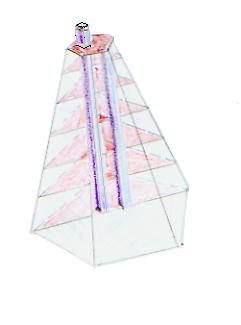 To build it, I imagined a lopsided pyramid (take a pyramid, grab one bottom
corner, and pull it out; this single edge might be converted to two edges, to
create an irregular pyramid, to allow more usable volume.) On the short side of the pyramid would be
regular floors, perhaps going up to 20, with elevators and utilities and
standard offices. On the long side of the pyramid would be open space:
each floor on this side would be composed of a concrete and steel cast of
walkways and office squares (with partial walls as handrails), taking up only a
small percentage of the possible floor area. When these were in place, the
long side of the pyramid would be mostly open, into which volume plants (with
watering hoses, etc.) would be hung. The cast hallway and office frames
would be designed to allow appropriate vertical column support. The walls
on this side would primarily be glass.
To build it, I imagined a lopsided pyramid (take a pyramid, grab one bottom
corner, and pull it out; this single edge might be converted to two edges, to
create an irregular pyramid, to allow more usable volume.) On the short side of the pyramid would be
regular floors, perhaps going up to 20, with elevators and utilities and
standard offices. On the long side of the pyramid would be open space:
each floor on this side would be composed of a concrete and steel cast of
walkways and office squares (with partial walls as handrails), taking up only a
small percentage of the possible floor area. When these were in place, the
long side of the pyramid would be mostly open, into which volume plants (with
watering hoses, etc.) would be hung. The cast hallway and office frames
would be designed to allow appropriate vertical column support. The walls
on this side would primarily be glass.
So, to go to work, you'd enter in at the ground floor (probably a very open lobby, with shops, etc.), take an elevator up, and then walk out into the open space on a walkway to your office space. You'd feel suspended in space, with greenery all around. The plants would also act as acoustic elements, cutting down echoes and noise.
Solar heating would likely be significant, so this might be ideal for a colder climate. Natural venting and air circulation should result in this be a fairly healthy building. To top it off, I'd slice off the very top of the pyramid, creating a deck with outdoor café.
(First idea: 1981; on this web page, December 16, 2002)
I've always been intrigued with lighter-than-air craft. I believe that it would be possible to build small recreational airships, and that these would offer some extremely novel experiences. (While I've thought of this as "Zeppelin Yachts", this has nothing to do with the Zeppelin company, which is actually making airships again: http://www.zeppelin.com/)
Some time ago I illustrated a brochure for an imaginary company which would produce such yachts; I offer only a brief summary here.
 At the small end would be tethered helium balloons with one or two seats,
just to allow one to easily get up in the air. Helium can be expensive, so
it would be recompressed after each use.
At the small end would be tethered helium balloons with one or two seats,
just to allow one to easily get up in the air. Helium can be expensive, so
it would be recompressed after each use.
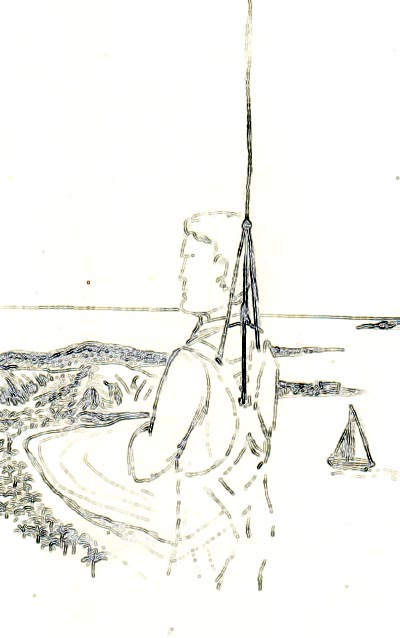 A sports version would be self powered, and would have a unique feature: a
precision winch with remote control, so that you could wear a harness, dangle
near the ground, and control your direction of motion. While this sounds
very strange, imagine it: you start at a beach, with the airship high above; you
command it to lift you 20 feet, and head out over the ocean. If you near a
boat, go up a hundred feet or so, and come back down. It would feel like
flying. The airship itself would be instrumented, so that if it had to
change altitude (say, due to temperature change, ballast drop, etc.) it could
autocorrect the cable length, keeping you at a stable height.
A sports version would be self powered, and would have a unique feature: a
precision winch with remote control, so that you could wear a harness, dangle
near the ground, and control your direction of motion. While this sounds
very strange, imagine it: you start at a beach, with the airship high above; you
command it to lift you 20 feet, and head out over the ocean. If you near a
boat, go up a hundred feet or so, and come back down. It would feel like
flying. The airship itself would be instrumented, so that if it had to
change altitude (say, due to temperature change, ballast drop, etc.) it could
autocorrect the cable length, keeping you at a stable height.
A sailing version would be tethered to a small boat with a centerboard and remote-controlled rudder. Below the helium balloons would be a sail, and below that you would hang in a harness, say 20 feet above the water. This would sail just as a sailboat does, but with significantly less friction. I expect it would be a very exciting ride, feeling like flying. (The balloon itself might be combined with the sail, in an inflatable airfoil shape).
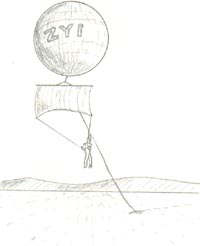
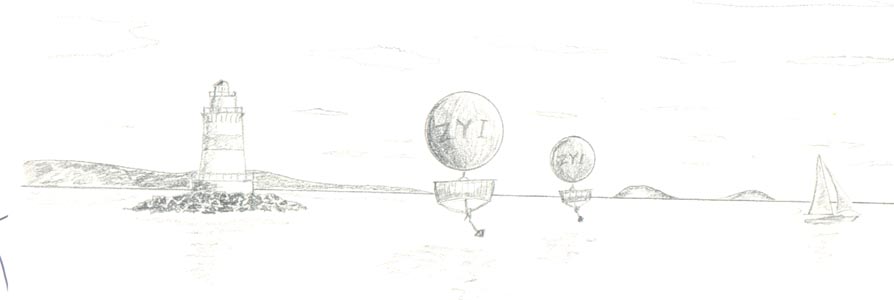
(These sketches were when I initially considered downwind sailing only. There is no reason not to use a Marconi-like rig; the sailships could sail upwind. While this seems non-intuitive, sailboat masts don't transmit much torque, only a single force vector - separating the sail and mast structure from the hull therefore won't change the dynamics.)
After a little thought, I think that the right way to do the above sailship is to give the balloon an airfoil (sail) shape, so that there is only one thing to control - imagine a sort of kite with enough helium to safely keep its load up in the air.
Larger airship yachts might have cabins for extended cruising, sort of like campers in the sky. Modern materials, a high level of automation, and modern weather forecasting should make such cruising quite safe.
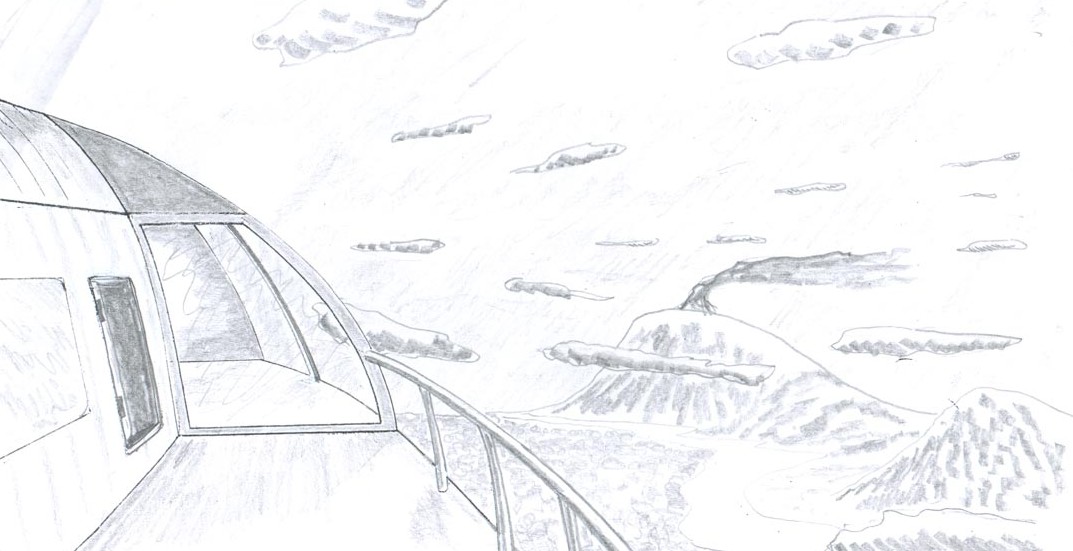
(First idea: 1983; on this web page, December 16, 2002)
I've thought about writing a sort of odd cookbook, one which would amuse as much as provide recipes. The idea would be to offer menus appropriate (or inappropriate, depending on your point of view) to certain holidays. Here are some of my ideas so far:
Groundhog Day (Feb. 2): Ground hog, of course: perhaps pork pie;
Valentine's Day (Feb. 14): Stuffed hearts of beef;
March 15 (the Ides): Caesar Salad, perhaps with chicken to represent Brutus et al;
Easter: Bunny (rabbit) in mustard sauce;
Cinco de Mayo: Something with 5 types of mayonnaise;
Arbor Day: Hearts of Palm salad;
Independence Day (July 4): Steamed Lobsterbacks (lobster tails; a nickname for British troops at the time.)
Bastille Day (July 14): Let them eat cake.
Christmas Eve: Reindeer steaks.
Well, you get the idea, such as it is.
(First idea: 1993; on this web page, December 16, 2002)
Why don't food stores print up and make available blank shopping list pages with categories in the order in which customers will walk through the store? If you walk into the Produce section first, then that would be the first category on the printed page (the page could indeed look like a map with named sections).
This would help guarantee customer loyalty, as if your list were on a page for a particular store, you'd be slightly less likely to shop somewhere else.
For the customer, it's convenience: your list is in the order of your travel through the store, so you get everything on one pass.
(First idea: 1994; on this web page, December 16, 2002)
This was something that I first thought of back when I was in grade school - when I first heard about atoms and orbits, and had that common (then) image of an electron circling a planet-like nucleus. The idea was that in a similar way, our star and planets might be part of a larger system, one which perhaps exhibits intelligent behavior on vast scales of distance and time.
When mentioning this to an adult at the time, it was pointed out to me that planetary orbits and electron orbits have very little in common; the discussion stopped then. Still, there was an unresolved fragment in my mind. It came back when I started to read about Chaos Theory. (See, for a non-mathematical intro, http://www.wfu.edu/~petrejh4/chaosind.htm).
The essential part of that that I wish to discuss is the great sensitivity certain systems may have to initial conditions, or perturbations thereof. For example, if we delayed the Earth in it's orbit just a little bit, this would effect the other planets ever after - an effect that would multiply itself, as the changed position of those planets would in turn further affect other planets and the Earth, possibly magnifying the initial change. Very slight changes in state may thus lead to very different results.
Such a system might be said to be computing something, although it is very hard to say what. We could take the solar system as a very sensitive analog computer, but we have no idea what (if anything of importance) is being computed.
Now add the rest of the galaxy; the inherent complexity is such that we can't even conceive of a computer which could accurately model the motions of all the stars, planets, asteroids, etc., other than the galaxy itself. Given the large distances involved, and the unfortunate limitation of the speed of light, what happens will happen over scales which our race is unlikely to experience. For the moment, ignore the scales of time and distance involved. In principle, is it possible that certain bounded parts of the universe show intelligent behavior? (I say "bounded", because if it's the whole thing, there's nothing to interact with such an intelligence, and it would be restricted to contemplating its own existence.) The number of components and the number of interconnections is greater than that of the human brain, so why not? While it's possible, I'm not sure we could figure out a way to ever know - but it's an interesting idea I think. What would the universe's memory have in it?
One friend of mine remarked that if we could read such memories, we could probably alter them, and therefore would seem like a sort of virus or disease of the universe. This isn't too pleasant a thought, but this entire idea is such a stretch that it's only use is probably in a science fiction story.
(First idea: 1984; on this web page, December 16, 2002)
When I was living in Boston after MIT, I was mainly in apartments, and I wanted to buy a place. The prices seemed to be climbing significantly every year, so that a condo one year at $55,000 might be $90,000 the next year, and then into the low hundreds the year after. I couldn't afford to live any place that I'd want to live.
I started to think of creative options. One was something I'd thought about when I first went to MIT: to buy and rehab an old railroad caboose, and park it on a siding off of Vassar St. I wondered if I might do the same thing with an old Pullman railroad car.
I used to drive (and walk) around the city for the fun of it. One day I was in the Fort Point Channel area, and an idea hit me. There were a number of old warehouse buildings there, and I thought I might be able to build a small penthouse on top of one of them. I looked around and found one particular rooftop (outlined in red below) that I liked:
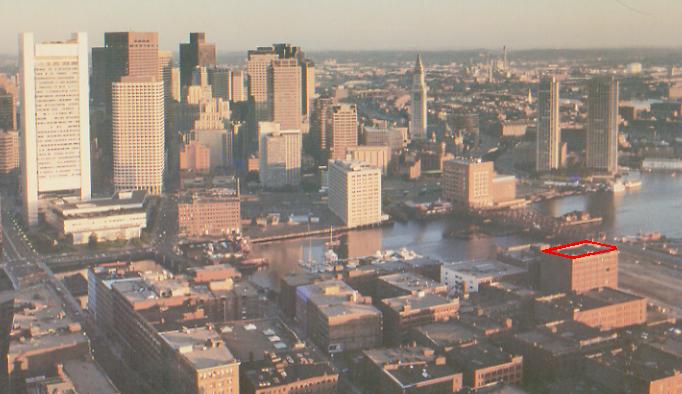
This was a good spot for several reasons: the tall buildings across Fort Point Channel were dramatic, and ended at the channel, and to the right and lower-right corner was Boston Harbor, so one would have a great view. As I recall the address was 44 Farnsworth St., although I also noted buildings at 321 Summer St. and 495 Summer St.
I wanted to use an ancient Roman idea for the penthouse: have a central garden with the house surrounding it, so that I'd have a quiet, non-urban space to escape to. This meant that the house would basically be "U" shaped, and I wanted most of the walls to be glass, so that I could see either the city or the harbor easily. Here's an early sketch:
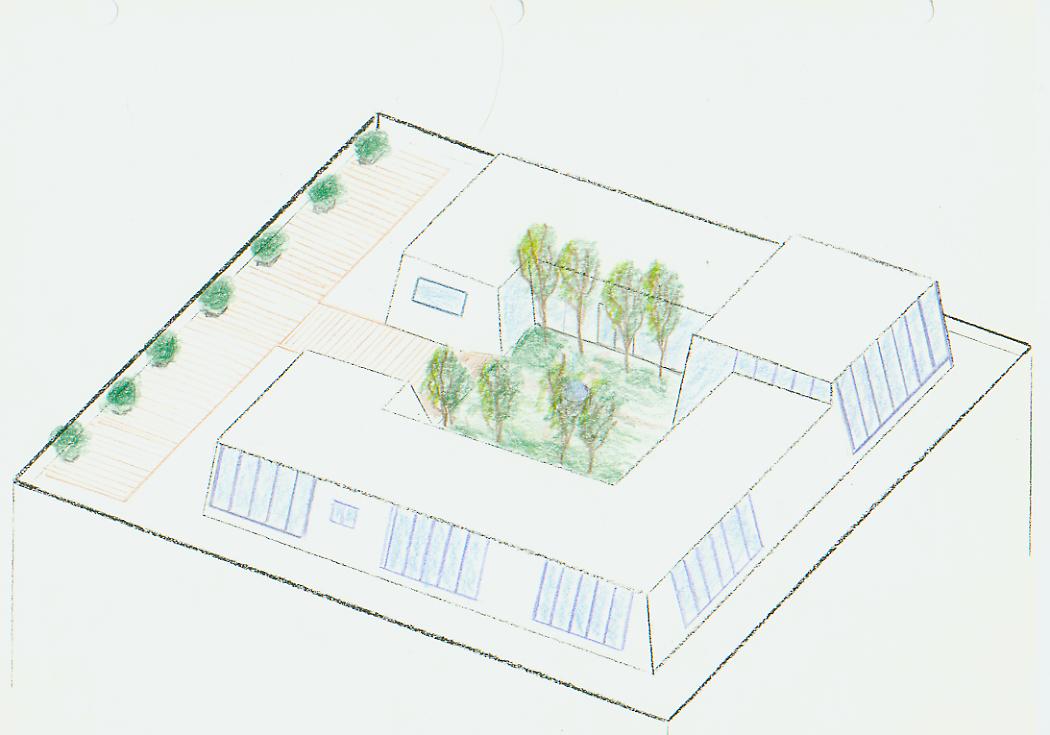
The larger bump on the upper right was to be the living room, and that (upper) side of the house was the more public side. The lower part had a library and two bedrooms.
 In
this plan sketch, you can see the master bedroom at one end of the private wing
(top left), with a private bath. Below that would be a second bathroom and
second bedroom, then the library at the bottom.
In
this plan sketch, you can see the master bedroom at one end of the private wing
(top left), with a private bath. Below that would be a second bathroom and
second bedroom, then the library at the bottom.
One would enter the penthouse in the bottom center, and either move left through French doors into the library or right into the living room (or straight into the garden). The kitchen and pantry would be at the end of the public wing (right, top). I might add a bathroom where the pantry is, and moved the pantry, so that guests would not have to venture into the private wing.
Hallways would run along the inside of the garden wall, with doors in the center of each side. At the top of the drawing would be an outdoor deck, perhaps with a canvas tent over part of it. The dining room would look south over Boston harbor. I'd have wanted a fountain in the center of the garden, in part to mask city noise, so that it would be an area which would be very un-city-like.
I pursued this as far as I could; I found the owner through municipal records, and I hired an architect and a lawyer; we could not put a deal together with the owner to make it happen, and I ended up buying and remodeling a condominium at 483 Beacon St. in Back Bay.
I still think it would be an excellent idea, although now that I'm married and have kids I'd have to do something slightly bigger - perhaps two levels for some of the structure. I might also enclose the garden in glass (e.g. a greenhouse), so that the space could be used and enjoyed during the winter months.
(First idea: 1983; on this web page, August 20, 2004)
This is an idea that occurred to me in the early 1980's, and I still haven't seen anyone do it. I wanted to build a device that would appear to be a blackboard, but which would be electronic instead. My first approach was to use a rear-projection TV, and instrument the screen to be touch sensitive. The user would write on the board with a non-marking stick, the position would be read and the projection pixels would change to "on".
Nowadays this might be doable with an LCD or plasma display. The particular technology interests me less than the possibilities.
An person might use the board in conjunction with handwriting recognition software, so for example as you wrote out algebraic problems, a Macsyma-like engine in the background could generate solutions. Or an instructor might write out a problem statement and solution, and have the computer driving the system produce notes with all of the solution steps included.
A person could move text around on the board, save it, print it, transmit it to other locations. Images from other sources could be shown - animations illustrating concepts, or web cameras. Other interactive programs could be brought in as needed, for example spreadsheets.
For interactive exploration of data (say before a board of directors, or students, or clients) it would be great. It would allow powerful collaboration between people who are also face-to-face. One could assign board areas to particular people, and allow them to control those areas from their own laptops, so that everyone could see everyone else's work in one place.
I think this will happen; I first wrote it down in 1984, and in the last 20 years lots of technical improvements have made it more practical to consider. Perhaps it will be built in the next five years or so, as display costs drop.
(First idea: 1984; on this web page, August 20, 2004)